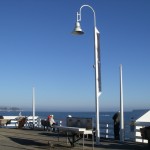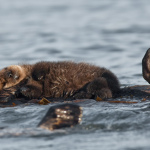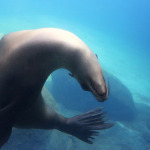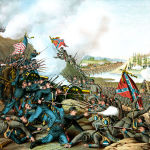The SciCom slugs have been out and about recently, perhaps seeking an escape from the swirling pre-graduation chaos?
Part 1: Paintings and Pumas
Last week, we attended the opening of the Science Illustration Program‘s exhibit at the Pacific Grove Museum of Natural History. Word on the street is that one of the Slugs is putting together a multimedia project about the event, so I’ll keep my comments short: It was fantastic!! (reptiles and insects and jellies, oh my!)
My goodness those artists are talented. I can’t wait to see the illustrations for our Science Notes features. Eagerly, eagerly waiting.
Coincidentally, the museum’s featured exhibit is about mountain lions — an entertaining surprise, since I’ve been writing about the furry felines for several months now…ever since one went slinking through my front yard. (proof: gazing outside while daydreaming can lead to good things)
Part 2: Muddy Spelunking
Thursday, instead of spending two hours in a classroom, we went on a little adventure. Our instructor, Associated Press reporter Martha Mendoza, led us first into a meadow where — horrors! — we stretched our writing skills with a chocolate tasting (I know, so rough). Turns out, describing food flavors isn’t so easy. Power to those wine critics, and to Martha for this exercise.
…AND THEN WE WENT SPELUNKING!!
[headlamp required]
There’s a cave on campus known as Empire Cave — carved out of the calcium carbonate (limestone) on which the university sits — and it’s a hidey-hole for wildlife undergraduates. Though the school tried to block the cave with a big cement slab, stubborn spelunkers dynamited the barricade, and three subterranean rooms and tunnels again await those willing to take the plunge.
Martha brought us there to write about being in the cave, the forest, and listening to noisy cars amidst forest songs — things you need to experience to creatively convey.
A rusty metal ladder descends roughly 15 feet from the jagged concrete hole into the
A rusty metal ladder descends roughly 20 feet from the lip of the jagged hole, guiding explorers into the cave’s first room. Near the cave’s entrance, the endangered Dolloff spider (Meta dolloff) supposedly spins its web, though I didn’t see any of the creepy crawlers. Who lives in the cave? The Empire Cave Pseudoscorpion (Microreagris Imperialis), a “species of concern,” which only inhabits this dripping, slimy cavern (didn’t meet that one either).
The first, high-ceilinged room is filled with tree branches and some trash. From the cave’s floor, a 25-degree incline loops back in the direction of the cave’s entrance. At the top of the rocky hill is the
The first, high-ceilinged room
The first, high-ceilinged room is filled with tree branches and some trash. From the cave’s floor, a steep incline doubles back in the direction of the cave’s entrance. At the top of the rocky hill is a tunnel that slopes down to the cave’s second room. It’s easiest to traverse this tunnel by hanging onto the ceiling and walls (well within reach), since the floor is slippery with mud, booby-trapped with boulders, and riven with tree roots (curious and curioser…)
Several weeks ago, Sandeep (‘Doop) and I ventured into this sloppy wonderland and were forced to stop partway down the tunnel since recent rains had flooded the passage.
Today, the passage was open, and we happily squelched through the mud. Indeed, there must have been a sh*t-ton of water before, since the cave just kept going and going…and I’d thought it had just been a big puddle.
Keith (K-Tron!) remarked that trudging through the mud sounded like walking on bubble wrap: the mud insistently sucked on our shoes, reluctantly releasing them with a loud Pop! as we pushed forward.
As for our assignment?
I wrote that I was drawn deeper into this moldy mineral chamber as though caught in a
I wrote that I was drawn deeper into this moldy mineral chamber as though caught in a rocky tractor beam…there was no turning back — onward!onward!gogogo! — until we hit a wall.
Or so I thought. According to a cave map, somewhere in that wall lurks the entrance to another room, waiting to be discovered by this Slug. I’m going back…
And thank you, Martha!
Epilogue: Spelunking runs in the family.
After coming home covered in mud from my first outing in Empire Cave, I found myself at the receiving end of enthusiastic inquiries about the cave from my dad. (how big? how deep? rooms? tunnels? stuff inside? water? stalagmites? stalactites? bears? — not the last one.)
“Huh?” I thought. “Since when is dad concerned with all things subterranean? I thought his interests lay wayyyy above ground.”
Turns out, my dad is a super-spelunker.
In the 1960s, he and his buds spent their down-time exploring caves near the National Radio Astronomy Observatory in Green Bank, West Virginia. One of those caves, he says, is among the most spectacular in the eastern United States.
It’s called Cass Cave, and this cavern is no joke — parts of it are accessible only by adventurers doing their best earthworm impressions, and its tunnels and rooms extend for miles.
But, “The most spectacular thing in this cave is a big waterfall,” my dad says, of the more than 100-foot underground cascade. “To get to the best part of the cave you had to climb down the waterfall (with ropes). The geometry of the situation was such that you had to go up and down IN the waterfall, with freezing water pouring all over you. It was quite an adventure.”
I’ll say.
Conclusion? Dad’s badass.
[More Cass Cave recollections here, from a fellow who was at Green Bank around the same time.]
The End.


































Excellent! I want to know more about the lions in your area.
I seem to remember a box full of spelunking gear when I was growing up, and probably also stern warnings not to play with it. Of course, to an inquisitive 12 year old boy mind, that actually means don’t get caught…
HA! Did you find some treasures in there? Incidentally, where is all that stuff now? Retro headlamps would be sweet…
Re mountain lions…they are gorgeous. Here are a few links!
Two recent Santa Cruz Sentinel Stories:
http://www.santacruzsentinel.com/ci_17722900
http://www.santacruzsentinel.com/ci_17669956
New Scientist:
http://www.newscientist.com/article/mg21028094.000-on-mountain-lion-patrol-in-the-california-wilds.html
And….Chris Wilmers, UCSC environmental scientist (he’s doing the work I’ve been covering — it’s way cool. The Bay Area Puma Project site has a bit more info):
http://people.ucsc.edu/~cwilmers/
http://www.bapp.org/
I went spelunking with your dad when I was visiting in WVA some time in the early sixties. We were the only ones to go and we did wear carbide head lamps. I was a complete novice at spelunking and not too agile. It was interesting but we probably should have had more people with us. I don’t remember a whole lot although there were bats hanging from the ceiling and several large rooms to the cave.
Hi Aunt Alma! There’s something totally charming about going spelunking while visiting…do you have photos? I would love to see a pic of you two about to enter the bat-cave (or having recently emerged!)
n